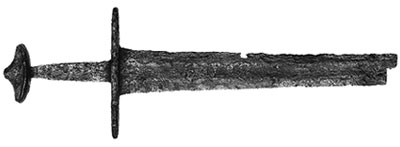TEDDINGTON, UK, Jan. 6, 2009 – Scientists at the National Physical Laboratory (NPL) in Teddington have analyzed the contents of Viking swords from the Wallace Collection fine arts museum in London, shedding new light on trade routes in the Middle Ages.
Using a highly calibrated scanning electron microscope, NPL analyzed the carbon contents of 1-mm-diameter steel samples from Viking-age swords obtained from various museums in Norway and Finland.
Museum curators were researching the steel structure of ancient swords to find out more about where they had come from. To achieve this, they analyzed examples of ancient weapons to determine their carbon contents. Those with a very high carbon component likely were made with crucible steel, which was available only in India and Central Asia.

The sword from the Landesmuseum Wurttemberg in Stuttgart, Germany, has the inscription of its maker's name spelled +VLFBERH+T (This was made of a high-carbon steel and would have been a very hard sword). Photo courtesy of Alan Williams.
Standard metallographic techniques that compare samples with published atlases of alloy microstructures were unable to determine the carbon contents of Viking-age swords. So, the Wallace Collection turned to the experts at NPL to come up with another way of assessing the samples.
The scanning electron microscope revealed that the swords were made of imperfectly melted steel formed from a mixture of iron and carbonaceous materials that had been heated to produce high-carbon steel. NPL's results match descriptions of ancient sword-making in Herat (now Afghanistan) by ninth-century Arab philosopher and writer Al-Kindi. This fact links the swords to a known Viking trade route down the Volga and across the Caspian Sea to Iran; until now, however, it was not known that Vikings had brought crucible steel back to Scandinavia or had integrated ancient Arab steel making methods into their own swordsmithing techniques.
"Our role at NPL was to use our measurement expertise to analyze tiny fragments of Viking swords and determine the source of the steel used by the Vikings to make them,” said Tony Fry of the NPL. “Standard methods using atlases of microstructures to compare optical images with an image in a book is a difficult method to use; it is subjective and prone to generalizations. By mixing scientific expertise with a top-of -the-range electron microscope, we were able to provide a quantifiable value rather than the standard qualitative approach of using an atlas, and enlighten our understanding of trade in the Middle Ages."
"Sword-making in Viking times was important work, to the point that the best smiths had their work imitated and copied,” added Alan Williams, consultant archaeometallurgist at the Wallace Collection. “On their travels, the Vikings were keen to pick up any innovative new means of improving their sword-making, but until now we haven't known where they have sourced some of their materials. The results from NPL confirm for the first time that the material analyzed was brought by the Vikings from the Middle East to the Baltic area – and thrown new light on an important trade route that was in use until the 11th century."
For more information, visit: www.npl.co.uk